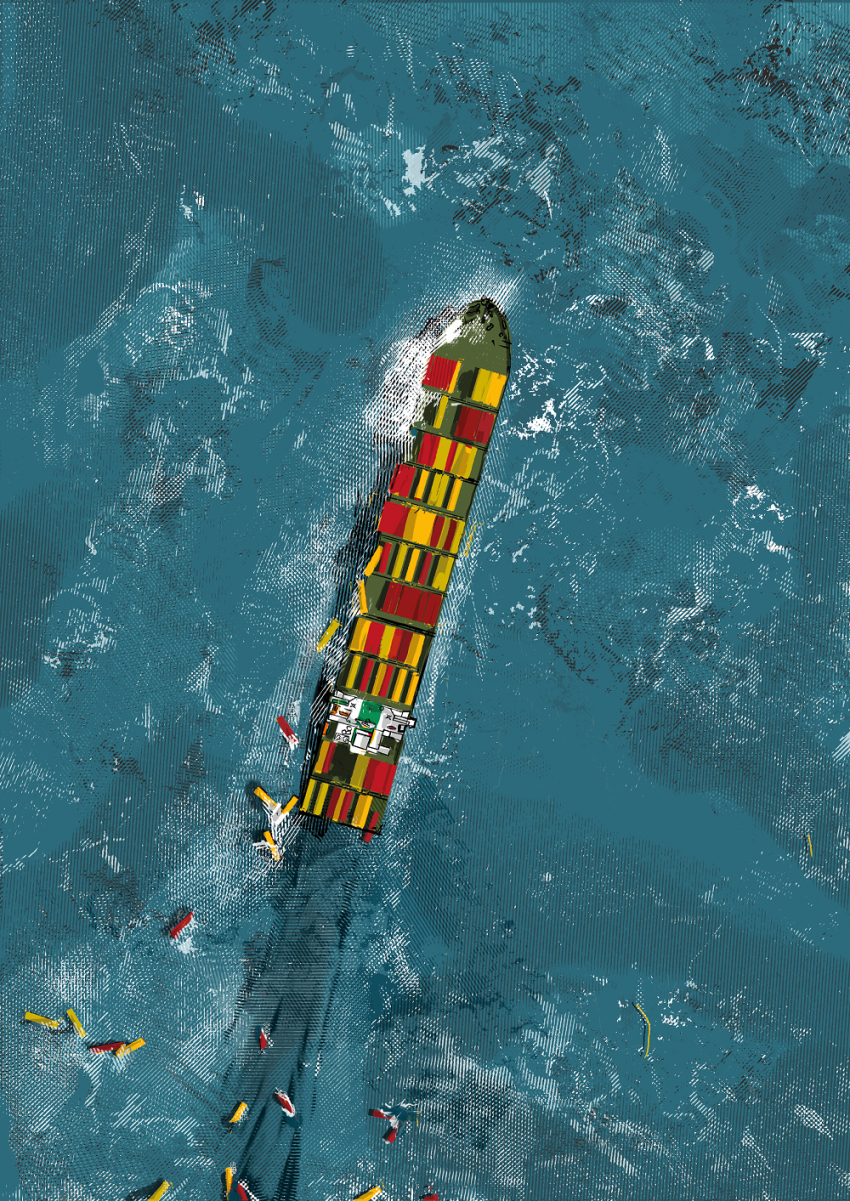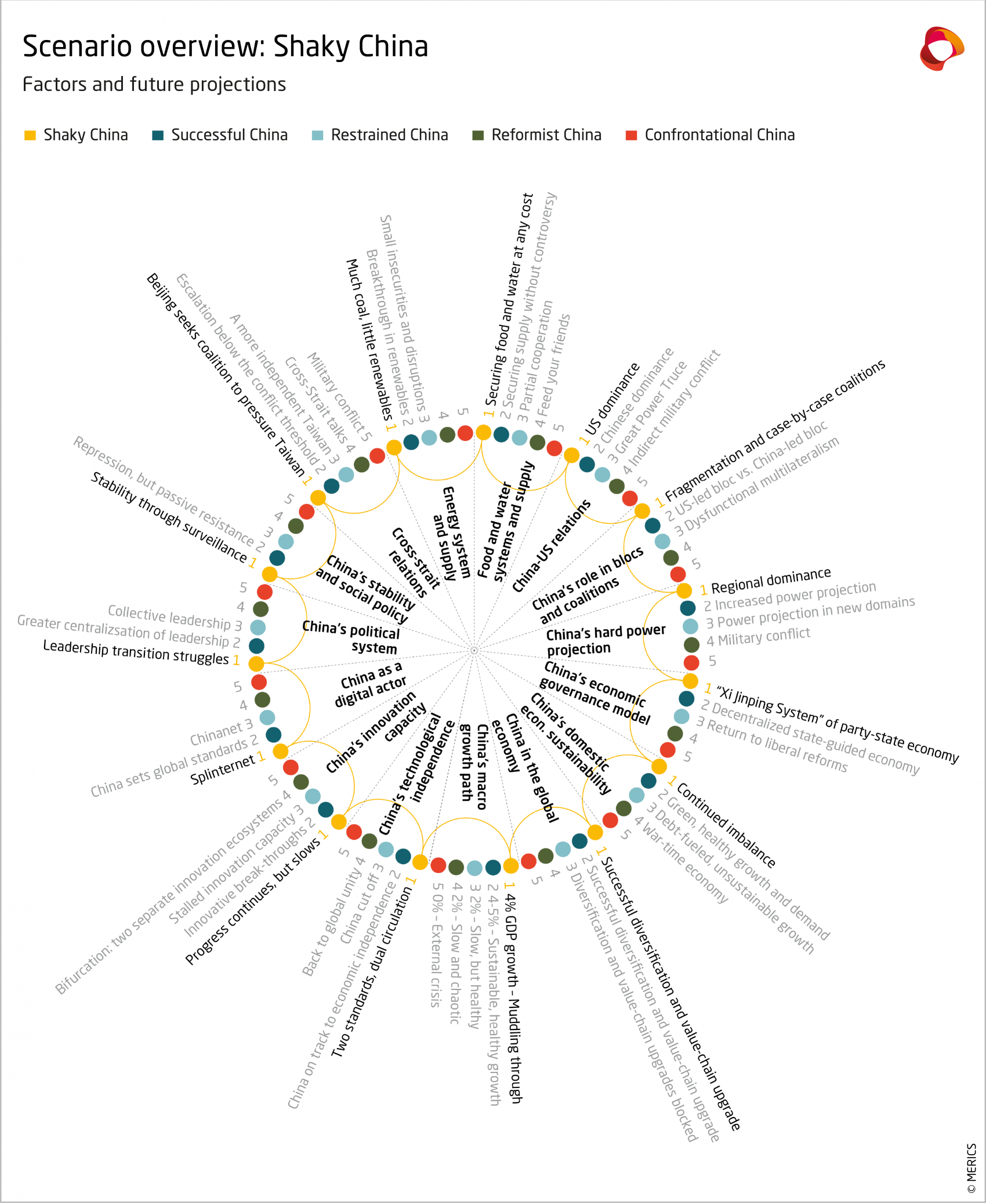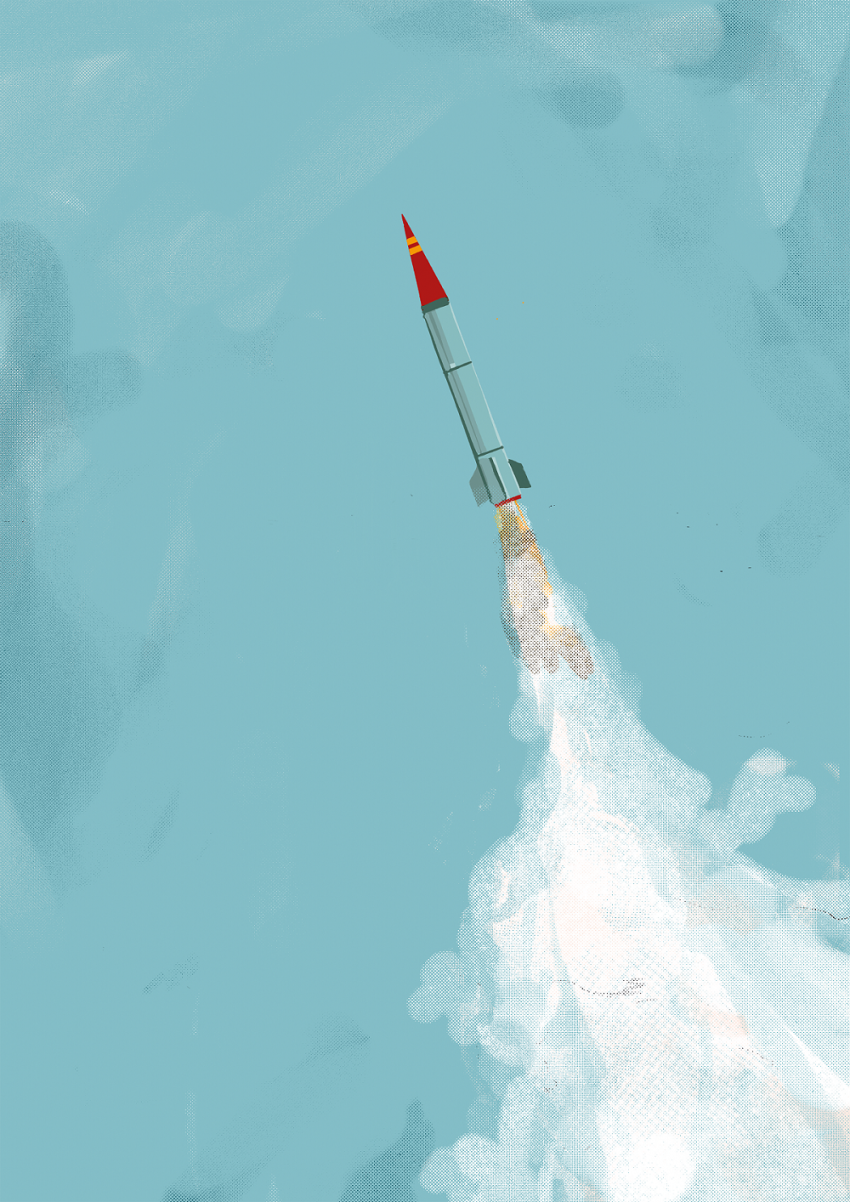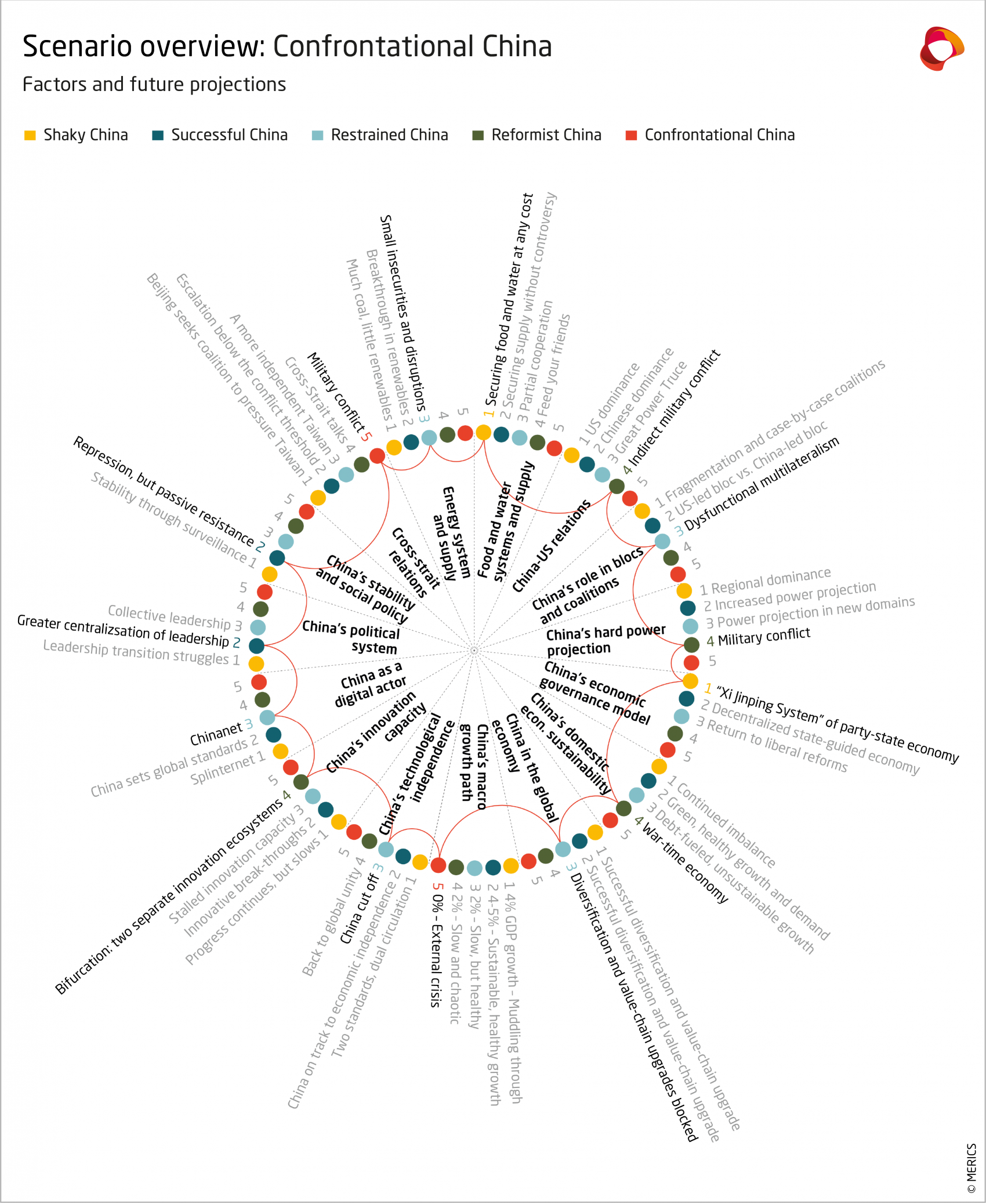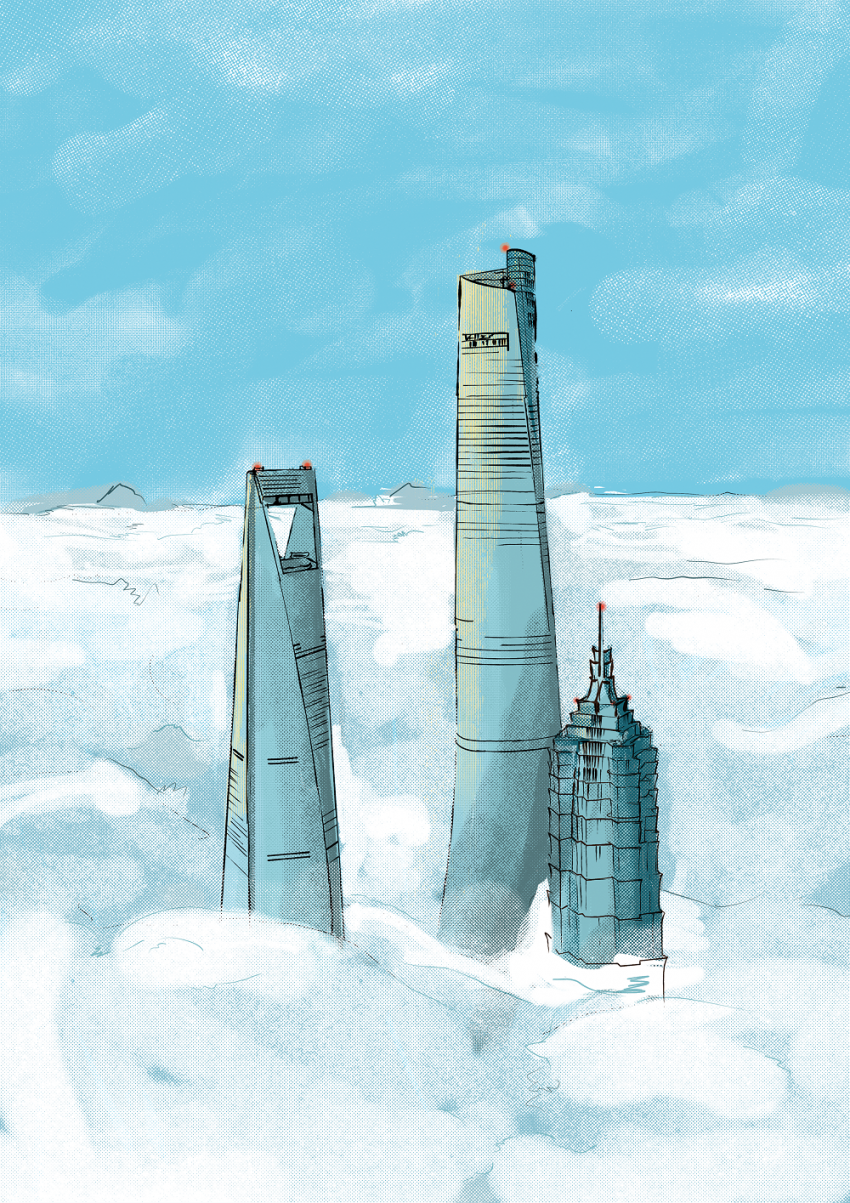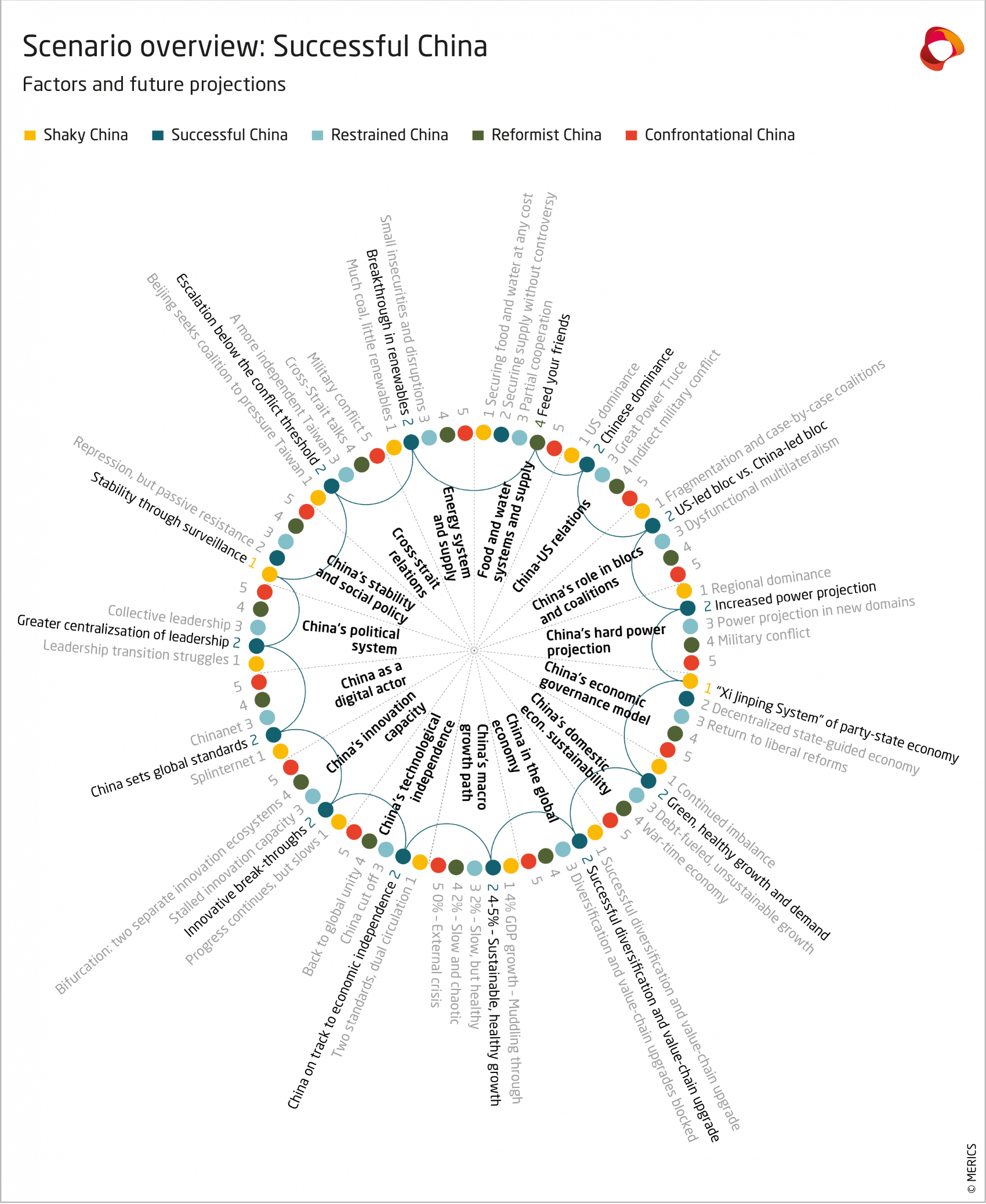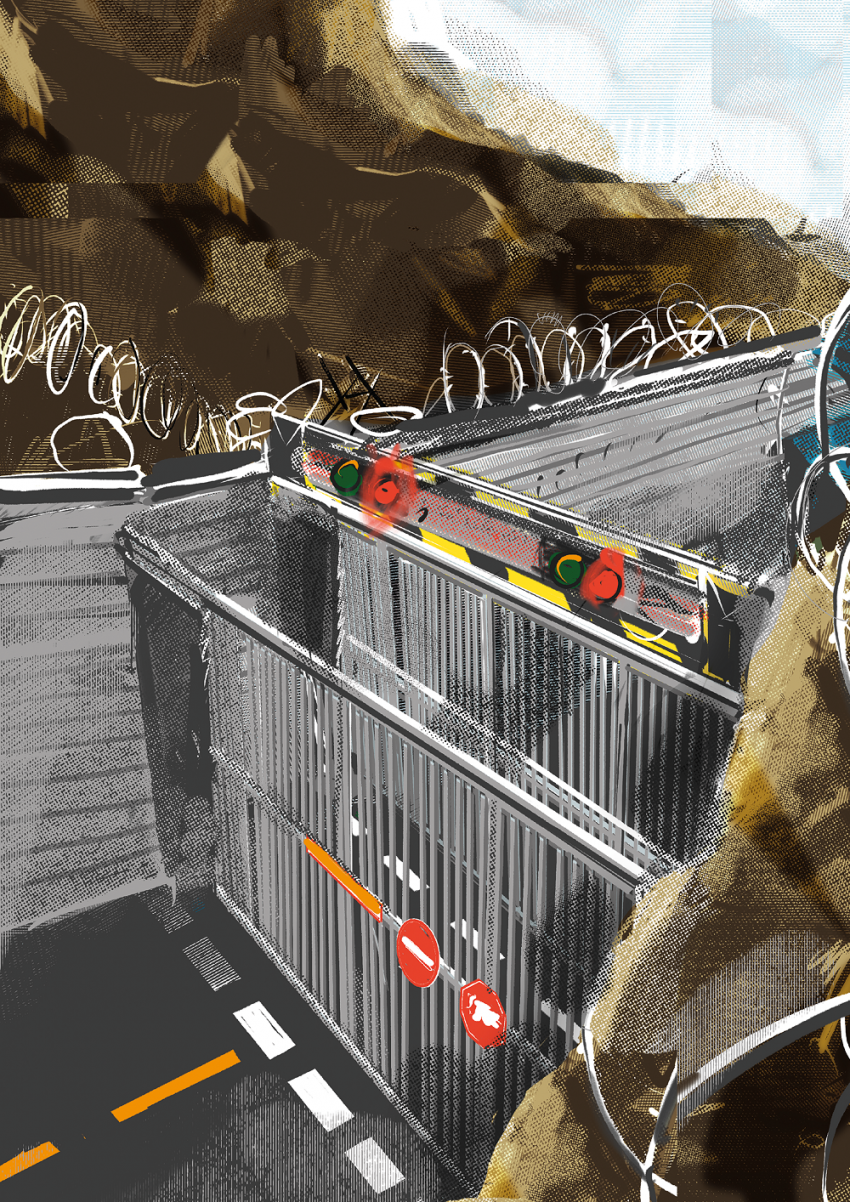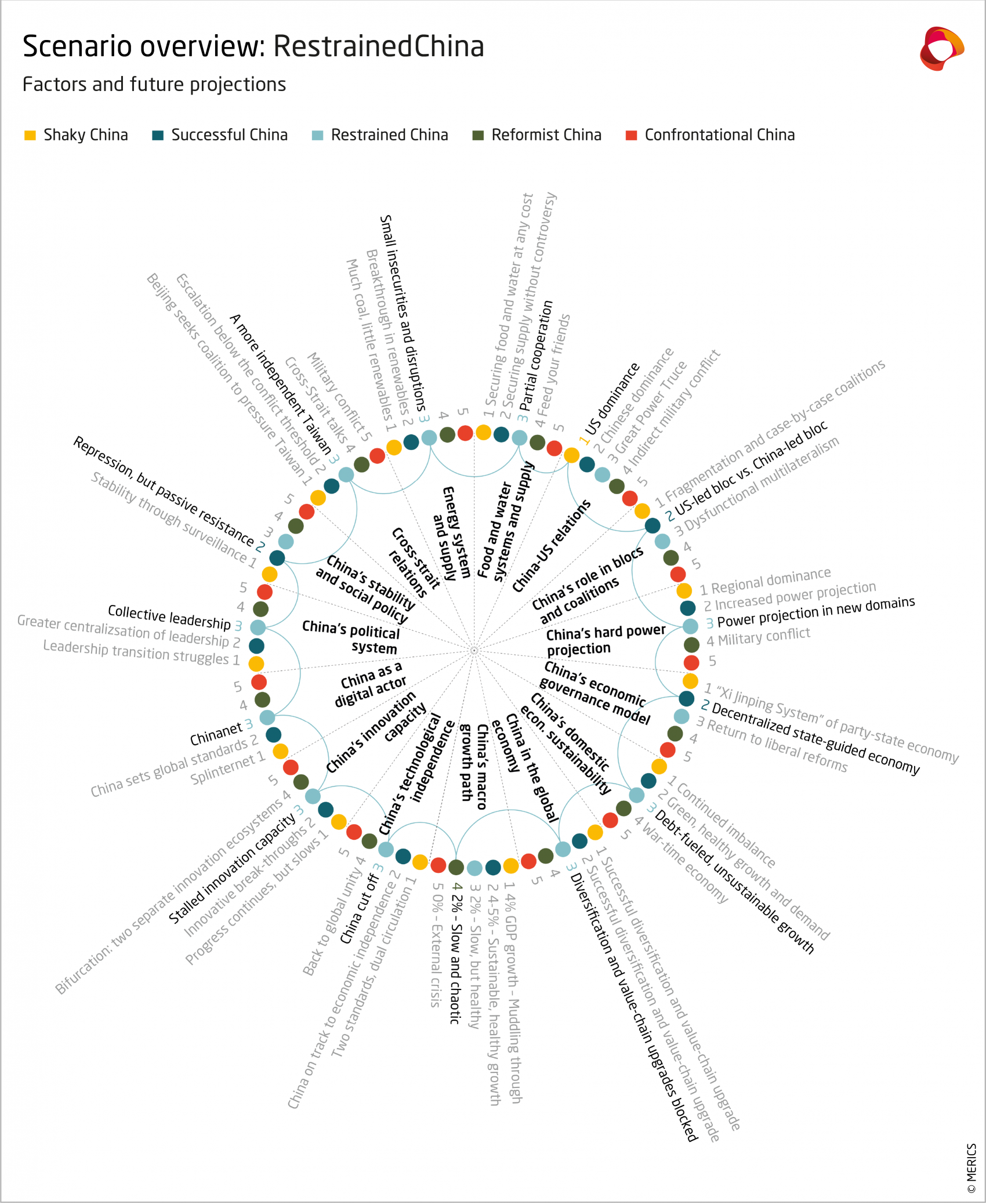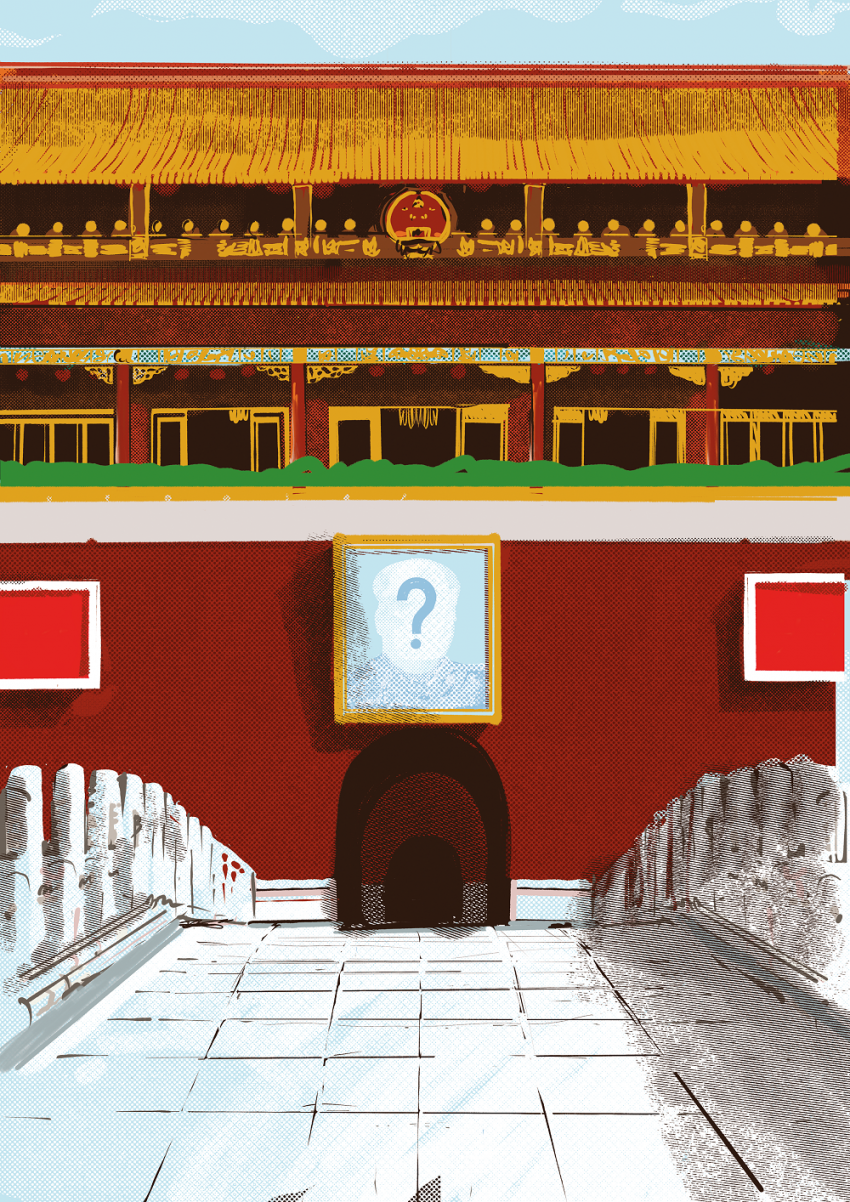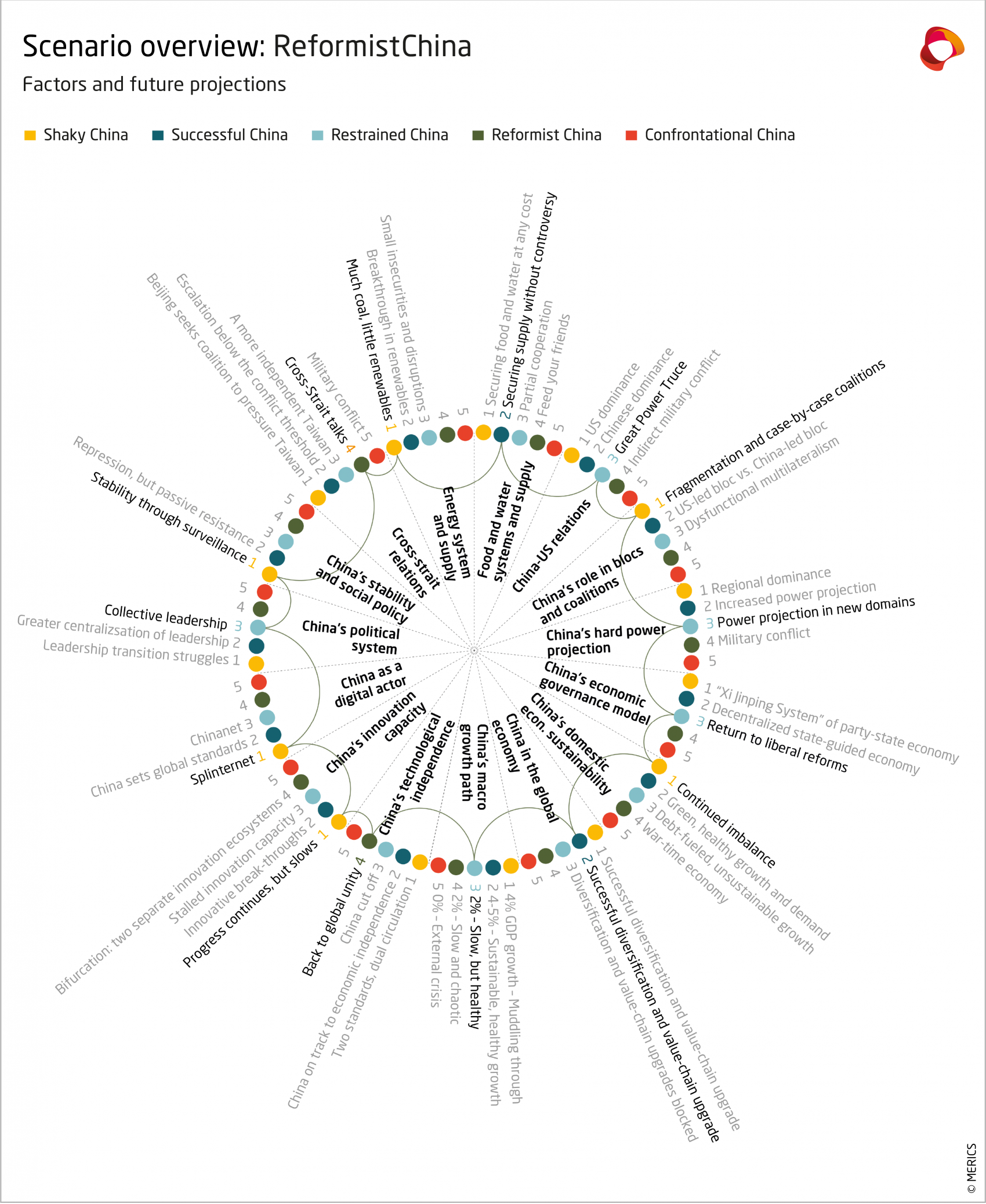

Scenario descriptions
You are reading the "Scenario descriptions" chapter of the report "Shaky China - Five scenarios for Xi Jinping's third term". Click here to go back to the table of contents.
Shaky China
This is the baseline scenario: China will continue along its current trajectory. Xi Jinping struggles to manage the country’s numerous challenges, most critically a slowing economy.
This is the baseline scenario in which China’s economy, politics and engagement with the world follow the trends seen at the outset of Xi Jinping’s third term in office. It is a muddling through scenario: China neither makes impressive progress, nor faces an existential crisis.
In this scenario, mixed signals make it hard for analysts to determine if China is on track to meet the goals of becoming a “modern socialist country” in 2035 and reach “rejuvenation” in 2049; whether growth has peaked; or if China is heading into deep trouble. There will be success stories (perhaps more supercomputers, impressive advances in space, or demonstrations of military power) that Beijing will proudly present to its people and the world as proof that China under Xi remains on the rise. At the same time, there will be failures and atrocities (perhaps insolvencies at banks or real estate developers, financial and job stress, or yet more repression of ethnic minorities and religious groups). Any news of these will be censored in China but will unsettle many in Europe or the United States. Xi’s “New Era” will be haunted by old problems. The prominence given to “stability and control” in his agenda underscores that the system stands on shaky the ground.
Scenario outline
The greatest headaches for China’s leadership lie in its slowing economy, the ripple effects it creates and the difficulties of shifting to a more sustainable economic model. Even if GDP could be expected to grow at 4 to 5 percent annually, the price for such relatively stable expansion would be high. Growth remains unbalanced and dependent on non-sustainable routes to economic expansion, such as infrastructure investment and high exports. China’s party state continues to have a strong hand in the economy, issuing tight guidance on specific industries and key technologies. Doubling down on industrial policy and investment is likely to weigh down overall economic efficiency still further. All companies are expected to fulfill state objectives, with the party insisting on patriotism and redistribution through policies associated with ideas such as “Common Prosperity”.
China has had mixed success with efforts to diversify its export markets and access to key imports such as critical raw materials or high-tech components. Exports of medium-tech products remain the core of China’s economic model. There has been some value chain upgrading and success in some high-tech technologies, but overall China continues to lag behind in key high-tech industries. Where Beijing feels its economic security is at stake, it carefully regulates competition with foreign companies, giving domestic companies time to develop their own technology (“dual circulation”). Beijing has high ambitions for China to become an innovation powerhouse and has seen progress in some areas of applied research, but China remains uncompetitive in basic research. Where the government invests a lot of resources and shields innovators from foreign competitors, they manage to innovate. This is not enough to sustain China’s economy, nor to make it more innovation-driven in the long run. In the Global South, China continues to gain influence as a provider of high-tech products such as digital infrastructure and set norms. In digital industries, China has become a tech leader in surveillance, but its internet remains largely isolated from the world wide web, leading to a Chinese “splinternet”. Parallel standards interoperability and data flows remain critical issues and stand in the way of meaningful international cooperation.
Politically, Xi remains unchallenged, but is under high pressure to deliver. What the Chinese population cares about most, besides economic growth and opportunities, is Beijing’s social policies, such as reforms of the health, pensions or education systems. Xi has outlined a mix of new policies to provide better public services coupled with effective surveillance to contain discontent. If this mix proves “good enough” to maintain stability, Xi may have sufficient political power to extend his reign yet again at the 21st Party Congress. However, he will then be 73 years old and under greater pressure to reveal a path to an orderly succession. The party leadership will inevitably become preoccupied in one way or another with thinking about what comes after him.
The international sphere will be fiercely contested but continue to be dominated by the United States and its likeminded allies. Both sides share the perception they are in a great power rivalry that will shape the world for decades. But Beijing grudgingly accepts that – at least for now – the United States remains too powerful to be openly challenged. Both sides are trying to reduce their dependencies on the other, e.g. in technologies or critical supplies. But they are also making efforts to manage their competition to prevent the many brewing conflicts from escalating into an uncontrollable crisis that neither Beijing nor Washington wants.
The continuing rivalry between the two superpowers has a price for the international order. Institutions are weakened, even as most global institutions continue to follow the established rules and Western countries put up an effort to prevent China from changing them. Instead of broad international agreements, unilateral laws and mini-lateral agreements generate fragmentation. Frameworks such as China’s “Belt and Road Initiative”, the “Global Development Initiative” or the “Global Security Initiative” will continue to attract followers and partners in the Global South, but few will tie themselves exclusively to China. A welcoming attitude towards China‘s economic engagement is not necessarily mirrored in security cooperation.
As a military power, China is establishing itself as the most influential actor in its direct neighborhood. This is not enough to meet Beijing’s ambitions, but it helps expand and test its influence in the region. China may show more willingness to engage in regional military conflicts, e.g. over territorial disputes with India. China’s military build-up continues, with the aim of achieving dominance in the South China Sea and the Taiwan Strait in particular. Military pressure on Taiwan is increasing. Beijing uses its political, military and economic muscle to push other countries in the region to accept its ambition of “complete reunification”. At the same time, the United States is building its own coalition (e.g. with Japan, Australia, Philippines) to push back against Beijing.
Potential implications for Europe
As this is the “dynamic status quo” scenario, European governments face risks from volatile bilateral relations with China. Concerns include the politicization of economic relationships and supply chain dependencies. With the United States and China exerting substantial pressure, European states risk pursuing reactive policies rather than proactive policy making. This could lead them to overlook the opportunity that the “Shaky China” scenario presents; namely that there is still time, and room, for maneuvers to increase resilience, improve competitiveness, expand the mitigation toolbox and build alliances. European companies can pursue their China business strategies along recent trajectories (with signals about an increasingly constrained business environment already factored in). But they need to be aware of risks arising from more intense competition from Chinese companies, both in China’s market and third countries.
Confrontational China
In this scenario, tensions over Taiwan have come to a point where the grey-zone conflict is escalating and an open military conflict seems imminent. This leads to extreme bifurcation and far-reaching de-coupling between China and the West.
This scenario does not attempt to model a war over Taiwan. Obviously, a military conflict involving China and the United States could have catastrophic global consequences: the ultimate, extreme outcome would be World War III, which should not be discarded as mere dystopian science fiction. Nevertheless, we stop short of trying to imagine the course an actual full-blown war would take and instead anticipate the dynamics in and around China that must be expected if tensions were to rise to a point where a war seems imminent.
Different pathways could lead to a situation that can be read as a point of no return. (If this is hard to envisage, remind yourself of the build-up of tensions before Russia’s 2022 attack on Ukraine.) Signals that an escalation will be hard or impossible to avoid might include Chinese military exercises modeling an invasion, massive cyber-attacks on Taiwan, propaganda preparing the Chinese people for a war or offensive lobbying by Beijing to rally its international allies behind it, most importantly Russia. Likewise, US assertiveness in the Pacific, including more deployments of forces, deliveries of weapons systems to Taiwan or official recognition of Taiwan’s political leaders could also lead to an escalation. Spiral dynamics are at play. Such tensions could drag on for months or even years, but any spark or accident could set in motion military plans that all parties have in place.
Scenario outline
In a “Confrontational China” scenario, the rivalry (and, in this case, open conflict) between China and the United States becomes the defining force shaping global affairs both politically and economically.
Both Beijing and Washington would use all available means to get other countries to choose sides and to show their support militarily, politically and economically, by cutting ties to the other side wherever possible. The decoupling, which has been part of political rhetoric for years but has only materialized in limited ways, could become a force sweeping across all sectors - from tourism to academic cooperation to joint efforts against climate change. Multilateral institutions such as the UN or G20 could quickly become largely dysfunctional.
The realization that the world may be about to head into a military escalation over Taiwan would have catastrophic effects on the global economy. The United States and its allies would use sanctions and every kind of political pressure to cut China off from large parts of the global economy. An open-ended breakdown in supply chains would likely trigger a global recession, including a financial markets crash and massive problems for corporate financing. China would be hit hard, suffering from flat or negative economic growth.
Western sanctions and pressure would also largely cut off China from global technology and innovation ecosystems. It would be prevented from acquiring the materials and talent needed for key technologies. China’s progress towards value-chain upgrading or technology sovereignty in areas such as semiconductors would be halted, laying bare its dependency on imports of high-tech systems and components.
China would have to further intensify its efforts towards self-reliance. Even if it managed to join forces with other countries dissatisfied with the United States, China’s innovation system would suffer severely from losing its links with the rest of the world. The world of technology would experience a radical bifurcation, as the West would expel Chinese-designed standards from most industries. China’s tech firms would develop domestic solutions to comply with Chinese regulation. China’s netizens would live in an almost completely isolated “Chinanet”.
China’s government would do its best to camouflage such vulnerabilities by partly shifting to a war-time economy: it would reorient sections of the economy along war-time principles, such as pushing high quantitative growth through the military-industrial complex by building weapons and military supplies. At the same time, China is large enough to buffer against many shortages by prioritizing supplies to strategically important areas, such as the major metropolises.
What would this mean for China’s political system? Probably little change. China has been in a resilience and struggle mode for years, making preparations to stay functional in exactly this kind of situation. Xi Jinping would likely double down on policies of stability and control by further centralizing key government functions and steering the country from within a very small circle of trusted allies.
Socially, an economic crisis, supply shortages, travel restrictions and a harsh political climate would lead to widespread dissatisfaction. Unemployment would rise, particularly youth unemployment. Parts of the urban middle class and even the economic elite would feel alienated. To maintain stability, the CCP would turn to the toolbox of surveillance and social repression that it has developed so well and used to keep social tensions at bay during the Covid-19 pandemic.
Potential implications for Europe
This scenario entails the most detrimental disruption of the status quo. European governments and global institutions would face the need to react to global economic and supply chain crises; a global security crisis; and a global political crisis – all at the same time. Countries around the world would be under intense pressure to “choose sides” between the United States and China. For Europe, this would mean an obvious, though not pain-free, choice in favor of the transatlantic partnership. A very thin silver lining might lie in the opportunity to re-shore some business operations to Europe. European companies would be confronted with the massive effects of a global economic and financial crisis. Sanctions and political pressure could force corporates into sudden decoupling from China, similar to their exit from the Russian market in 2022. The very few beneficiaries would be defense and security-related industries because defense expenditures would rise in European, and likeminded, countries.
Successful China
In this scenario, China is seen to achieve key goals in Xi Jinping’s ambitious agenda: greater technological independence, sustainable green growth and global influence rivalling the United States. The West’s huge homegrown problems aid China’s success.
China’s ambitions must be taken seriously. It is worth remembering that China has time and again surprised the world (including itself) by being more successful than many thought possible. This fact should be set against mainstream analysts’ consensus view at the outset of Xi Jinping’s third term of a country with rising socioeconomic challenges that are unlikely to be overcome with his policy toolbox of increased centralization and control.
China doesn’t need to fulfill all its ambitions in order to be viewed as the more successful world power. Success is not necessarily measured in absolute terms: relative success could be enough to put China on a trajectory to surpass the United States as the dominant power, even inside the 5-year time frame of this scenario exercise. A home-made crisis in the Western world could play into China’s hands. Political and economic troubles in the United States (e.g. triggered by large-scale social unrest after the 2024 presidential elections) or the EU (e.g. triggered by the political, economic and social spillovers from wars in Europe’s neighborhood) could produce a situation where China is perceived as relatively more stable, resilient and future-oriented. Such perceptions matter. In a world dominated by great power rivalry, countries and companies watch closely which power seems on the more promising – or less troubled - pathway.
Scenario outline
The three necessary preconditions for the shift into a “Successful China” scenario would be i) a significant crisis for the West; ii) sufficiently tangible Chinese success stories that suggest China has an edge in major future developments and iii) a successful power play with the Global South. Such success stories might come from a combination of technological breakthroughs and advances in the shift to a more sustainable development model and leadership in green technologies.
Innovative breakthroughs in basic research and applied innovations in industries could create growth and give China a global technological edge. A fundamental upgrade in China’s innovation capacities would takes more than five years. However, a few high-profile advances could help to create the perception that China is on track to becoming an innovation powerhouse. Technological breakthroughs would also help put China on the path towards a high degree of economic security with both tech sovereignty and tech leadership in key areas. China’s government would be able to overcome chokepoints or engineer around them to avoid dependence on other countries. For China to reach this degree of independence in a relatively short time, a precondition would be that foreign technology providers cooperate largely on China’s terms, whether willingly or through coercion. China would then find it easier to set global standards, bolstered by support from developing countries and scant resistance from developed countries. The more that Chinese innovations become attractive to the rest of the world, the more China will be able to export high-tech products and capture greater value-added within China.
Another impactful signal that China is on the road to success would be strong evidence of significant progress in shifting its economy to a more sustainable development model and global leadership in green technologies. Indicators would be major investments in green infrastructure and green consumption patterns. GDP growth rates would reflect sustainable and healthy growth (roughly 4 percent) that can improve livelihoods in the long term.
On the global stage, China would increasingly be seen as the dominant power, coming out “on top” in rivalry with the United States and starting to rewrite global rules. China’s dominance cannot be expected to find broad acceptance immediately. The world would split into two blocs that view each other primarily as adversaries: A US-led block with G7 countries at the core versus a “coalition of the unsatisfied” led by China (with support from Russia). But it would be China that is more successful in solidifying its influence in the Global South and in international forums, and it may succeed in exporting specific aspects of the China model (including a deep-rooted surveillance state).
Militarily, China would increase its power projection, expanding both its capabilities and willingness to use traditional military capacity. This could include more intense intelligence gathering, additional overseas military facilities and abandonment of principles of non-interference and non-use of force in international relations. In the Taiwan conflict, Beijing would successfully keep pushing red lines, e.g. by taking control of some islands in the Taiwan Strait. At the same time, China would expand its hybrid warfare and project self-confidence that it can eventually tilt the military balance in the Taiwan Strait, while continuing to bide its time.
China’s success would go a long way towards cementing the authority of Xi personally and the political system he has installed. It would be propagandized (not without merit) that China’s system of one-party rule and a party-state economy, which takes a very active role in steering the economy and innovation system, can produce better results than Western democracies and market economies. This would surely provide Xi with the political power to centralize leadership even further and extend his tenure at the 21st Party Congress in 2027 in a “Helmsman” or “Party Chairman” role.
Potential implications for Europe
This scenario, in which China is perceived to be relatively more stable, resilient and future-oriented than the West, comes with the risk of a gradual erosion of the existing world order. European governments would be confronted with an increasingly assertive China that – together with Russia – moves to reshape global institutions according to its own interests. Economic dependencies on China would rise and would be increasingly weaponized. Also, China would exert increasing pressure on Western values and political systems. European governments that previously supported China’s course (at the cost of European and Western unity), stand to gain short-term benefits from privileged ties with Beijing, but would also lose their longer-term room to maneuver. European companies would need to operate in a world market where, increasingly, China is the technology leader that sets standards, dominates supply chains and aims to replace Western companies with Chinese ones. Businesses would face rising, often unfair competition in China and third markets, except for some short-term benefits and niche opportunities in industries where China urgently needs foreign technology.
Restrained China
In this scenario, China is in trouble: External pressure (from the United States and likeminded countries) and internal problems hamper China’s efforts to diversify its economy, maintain growth and achieve technological independence.
This is the scenario that China’s leadership has long been afraid of – and that many US policy makers are implicitly (or even explicitly) working towards: a “Restrained China” which is under tremendous pressure from the United States and likeminded countries and increasingly unable to successfully pursue its political, economic and technological agenda. On the sidelines of the National Peoples’ Congress in March 2023, Xi Jinping complained that “Western countries led by the United States have contained and suppressed us in an all-round way, which has brought unprecedented severe challenges to our development”. While many in the United States avoid the loaded term “containment”, it is official policy to compete with China in all areas, including its military ambitions and its quest for technological independence. At the same time, China’s own problems, in particular slow growth, an unbalanced economy and lack of innovation power, plus an over-emphasis on ideology and centralized decision making, can seriously hamper China’s development and lead to the country restraining itself.
Scenario outline
A necessary precondition for a shift into this scenario would be for the United States to succeed in forming a large alliance of middle powers, including the EU, Japan and key actors in East Asia and Latin America, with the shared aim of slowing and containing China’s development. For the United States and its partners, such an approach would bring massive economic and political costs. A move towards this scenario is therefore best imaginable if triggered by disruptive events. While we do not explore what would need to happen for such a coalition to take shape, it seems reasonable to envisage something similar to the G7 countries’ sanctions against Russia after it launched its full-scale invasion of Ukraine.
In this scenario, the international community splits into two blocs that view each other primarily as adversaries: A dominant US-led block with G7 countries and other likeminded partners at the core versus a “coalition of the unsatisfied” led by China and supported by Russia. As a military power, China’s ability to project traditional military capacity stalls, but Beijing focuses on building up non-traditional military capabilities (e.g. cyber warfare). Beijing would continue grey-zone operations against Taiwan below the threshold of an open conflict. Meanwhile, international support for Taiwan might grow, opening new room for maneuver, for instance membership of international institutions. Beijing would see this as an open provocation. Either way, tensions and fears about escalation in the Taiwan Strait would remain high.
Economically, this scenario puts China under tremendous pressure. The disruption of large parts of its international trade would force the government to bolster whatever internal sources of growth it can find. Even if China managed to avoid a recession and reach modest growth (around 2 percent), its economic expansion would be chaotic, unsustainable and debt-driven. Under stress, the central government might have to give up some of its control over the economy, e.g. by decentralizing more decision-making power back to the provinces and municipalities or by easing regulation of industries vital to growth.
While the government could release some of the short-term economic pressure, the technological consequences would be severe and damaging. In a “Restrained China” scenario, the United States and its allies would successfully block China’s value chain upgrades and pursuit of independence in key technologies. China would be isolated from cutting edge technology and the global innovation ecosystem. International companies operating in China would have need to withhold their latest technologies from China for fear of being sanctioned. The Chinese economy would have to rely on home-grown innovation. Although China has leading technology in some areas, its overall progress in many fields, including semiconductors, would be halted, along with its efforts to set standards globally. China’s economy risks falling into a middle income trap. Digitally, China would also be largely isolated.
The economic stress would increase social tensions and discontent. State propaganda would paint China as the victim of Western containment. Massive surveillance and direct social repression would silence any criticism of the leadership’s course. Within the party leadership, Xi would likely face a struggle to avoid challenges to his authority. Many in the party would hold him personally responsible for China’s troubles and openly or covertly start planning for the post-Xi era. This might possibly see a return to the collective leadership system that he has worked hard to discard.
Intense socioeconomic pressures and the likelihood of challenges to Xi’s authority, make this a dangerous scenario. There is a direct pathway to an escalation in the Taiwan Strait and the “Confrontational China” scenario. However, Western proponents of a coalition to counter China’s rise argue that external pressure is what is needed to trigger an internal course correction, putting the system on a “Reformist China” path.
Potential implications for Europe
This scenario is implicitly or even explicitly pursued by mainstream US China policy; it could create high political and economic costs on the European side of the Atlantic. European governments might find it harder to pursue an independent agenda vis-à-vis an emboldened United States. The risk of military escalation in the Pacific region may require increased defense spending. Partial decoupling from China would bring high costs and rising inflation. Nevertheless, a “Restrained China” scenario would also come with significant political opportunities: stability due to a strong alignment between likeminded countries; diminishing Chinese challenges to the global order and institutions; and more room for engagement with the Global South. European companies would suffer from their China business shrinking; partial (forced) decoupling; and the risk of secondary sanctions. The benefits include less economic and technological competition from China, a more levelplaying field in the West and better opportunities in the Global South.
Reformist China
In this scenario, China’s internal crises result in a political course correction. Confrontation between China and the West starts to ease amid hopes of a new “Deng-Xiaoping-moment” and a return to pragmatism.
This scenario would undo some of the features of the “Xi Jinping-system” that have put China in such fierce opposition to the West. A “Reformist China” implies a course correction and return to “reform and opening up”. Just as Deng Xiaoping’s generation decided Mao had over-reached in his zealous pursuit of a Communist paradise, this scenario anticipates that the CCP could come to a similar conclusion about Xi’s “road to rejuvenation”, seeing it as a blind alley rather than a route to restore China’s glory.
Although many in the West would like to see a return to a “Reformist China” and the “good old days”, it appears the least likely of the five scenarios in this study. It runs counter to Xi’s efforts to secure centralized authority and control. Nonetheless, many Chinese leaders and diplomats know that many foreign politicians and businesses still want to hear and believe that the era of “reform and opening up” continues and will remain China’s modus operandi. But even if the party decided to change course, a new reform push is unlikely to resemble what happened four decades ago, or what many in the West want or expect. The party might pragmatically discard some of Xi’s more extreme policies, e.g. towards technological self-reliance, while staying firm in areas where China is successful. A new “Reformist China” might become less of a rival and more of a partner again, but it would remain a fierce competitor.
Scenario outline
An internal crisis in China that calls for an urgent and fundamental course correction is a necessary precondition for a “Reformist China” scenario. It is relatively easy to imagine how such a crisis might arise. Rising socioeconomic stress means it is far from certain how effective Xi’s policy toolbox - focused on centralization and control - will be. Experiences from China’s handling of the Covid-19 pandemic show what powerful repressive mechanisms the party has put in place to prevent public discontent or internal rifts becoming visible. Alternatively, a situation where Xi exits the political stage (for whatever reason) could also trigger dynamics that create room for a course correction.
Whatever the pathway into a “Reformist China” scenario, the party would discard parts of the highly-centralized “Xi Jinping system” and reverse course to adopt the collective leadership model of the post-Mao era. A reshuffle at the top of the CCP hierarchy would be accompanied by some ideological shifts. Xi might end up with the same score card as Mao, “70 percent right, 30 percent wrong”. Regardless of personnel changes at the top, the party’s social governance mode would remain a mix of social policies that provide better public services and extensive surveillance to contain discontent. Maintaining stability and securing the party’s leading role would stay top of the political agenda. However, reform signals would go a long way towards reconciling those who have become alienated from the system and China’s direction, especially in the urban middle classes.
A “Reformist China” economic policy could see a return to more liberal reforms, like some of then-Premier Zhu Rongji’s reforms in the 1990s and early 2000s. The market would regain a more important role, with the government focused on regulation and rule-setting. The shift would not rebalance the Chinese economy overnight, but it might initiate a controlled deceleration of the economy towards slow, but healthier, growth. Under these circumstances, even low growth figures of around 2 percent could be seen as “taking a hit” to implement reforms, trimming unhealthy growth and expanding sustainable sectors.
China’s approach to innovation and technology would undergo similar liberalization and re-integration into global ecosystems. China’s government would proclaim the vision that with better integration, China could become more attractive to the rest of the world, build up exports of high-tech products and capture far more value-added within China. China’s quest for independence and tech-supremacy would become less acute. In return, Western countries would become less opposed to providing China with cutting-edge technology and more ready to trust in cooperation for mutual gain. China would be able to gain greater influence as an innovation partner, make progress in some areas of applied research and even set norms in certain industries, in particular for the global south. In digital economies, China would still maintain its own “Splinternet”, with data flows and exchange remaining a critical issue.
In the international sphere, a “Reformist China” could turn the tide of intensifying Sino-US rivalry. Washington and Beijing might arrive at an agreement to cease treating each other as adversaries, in favor of a “Great power truce”. The erosion of the international order and its institutions could be slowed, even if both sides continued competing for partners and coalitions and tried to strike unilateral and mini-lateral agreements. Being mindful of international perceptions and the need to deflate tensions, China would put less emphasis on projecting and expanding military power in traditional domains. Nevertheless, Beijing would continue to build up non-traditional military capabilities and pursue close military cooperation with Russia. Vis-à-vis Taiwan, Beijing would continue its grey-zone operations, though it would be less insistent on pushing red lines and less aggressive in its language. With receptive political counterparts in Taipei, Beijing might even reopen cross-Strait talks.
Potential implications for Europe
Confrontation between China and the West would ease. European governments and companies would have far more opportunities than risks. These include more stable political relations with China; renewed opportunities for pursuing cooperation and a partnership agenda. Lower tensions between China and the United States could yield greater political leeway for Europe. The risks would lie in over-enthusiasm and renewed naïveté towards China’s reforms and ambitions. A more pragmatic “Reformist China” is not necessarily a weaker or more Western oriented China. European companies would still experience strong competition from Chinese companies, but could compete in a more reliable, open business environment, which is more encouraging for long-term engagement.
You were reading the "Scenario descriptions" chapter of the report "Shaky China - Five scenarios for Xi Jinping's third term". Click here to go back to the table of contents.

